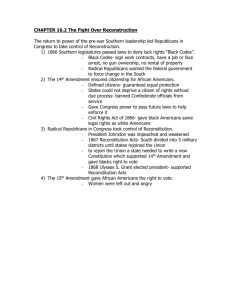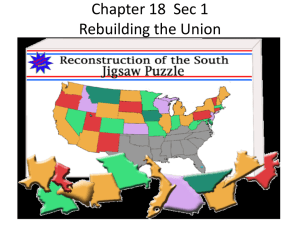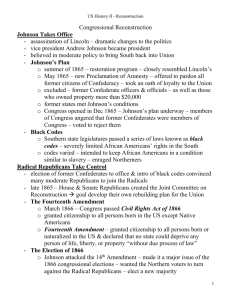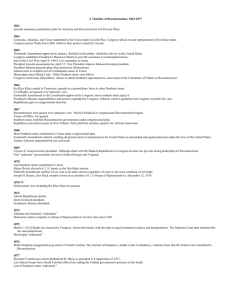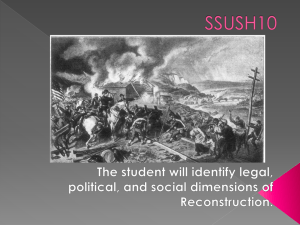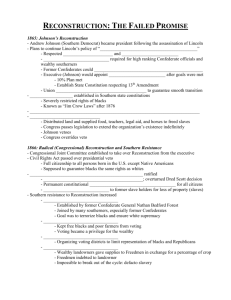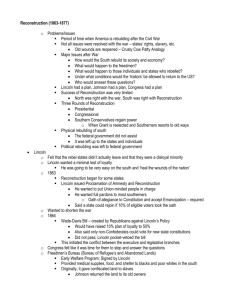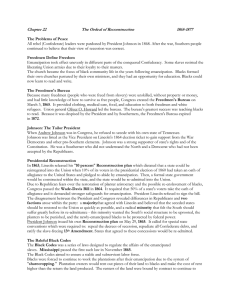Document
advertisement
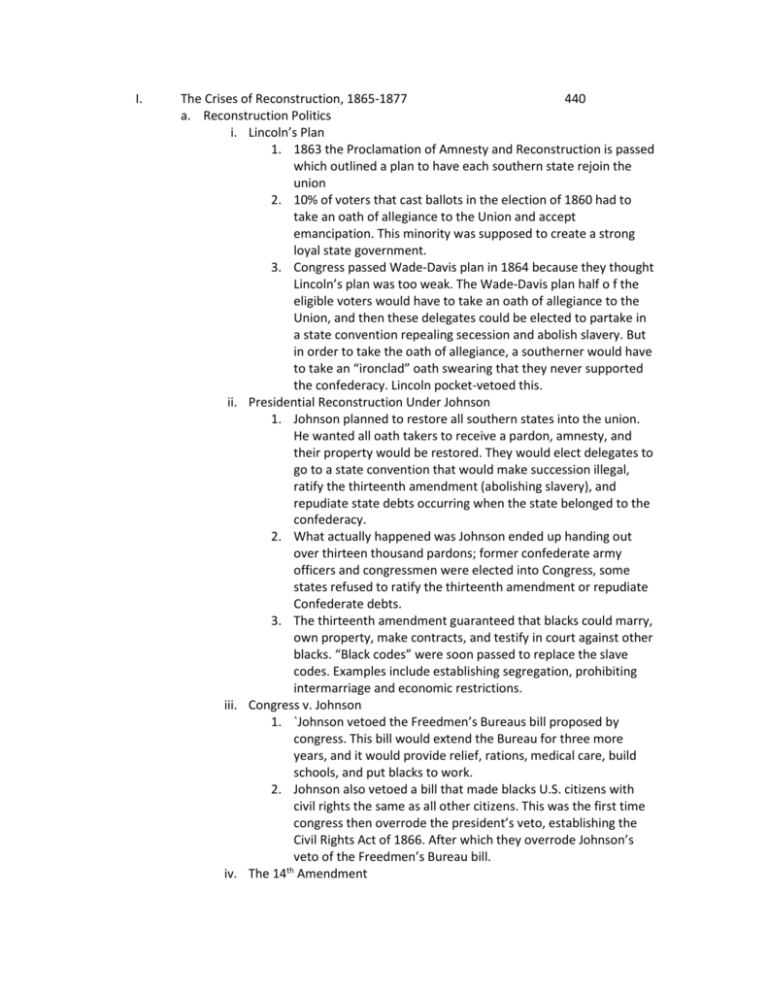
I. The Crises of Reconstruction, 1865-1877 440 a. Reconstruction Politics i. Lincoln’s Plan 1. 1863 the Proclamation of Amnesty and Reconstruction is passed which outlined a plan to have each southern state rejoin the union 2. 10% of voters that cast ballots in the election of 1860 had to take an oath of allegiance to the Union and accept emancipation. This minority was supposed to create a strong loyal state government. 3. Congress passed Wade-Davis plan in 1864 because they thought Lincoln’s plan was too weak. The Wade-Davis plan half o f the eligible voters would have to take an oath of allegiance to the Union, and then these delegates could be elected to partake in a state convention repealing secession and abolish slavery. But in order to take the oath of allegiance, a southerner would have to take an “ironclad” oath swearing that they never supported the confederacy. Lincoln pocket-vetoed this. ii. Presidential Reconstruction Under Johnson 1. Johnson planned to restore all southern states into the union. He wanted all oath takers to receive a pardon, amnesty, and their property would be restored. They would elect delegates to go to a state convention that would make succession illegal, ratify the thirteenth amendment (abolishing slavery), and repudiate state debts occurring when the state belonged to the confederacy. 2. What actually happened was Johnson ended up handing out over thirteen thousand pardons; former confederate army officers and congressmen were elected into Congress, some states refused to ratify the thirteenth amendment or repudiate Confederate debts. 3. The thirteenth amendment guaranteed that blacks could marry, own property, make contracts, and testify in court against other blacks. “Black codes” were soon passed to replace the slave codes. Examples include establishing segregation, prohibiting intermarriage and economic restrictions. iii. Congress v. Johnson 1. `Johnson vetoed the Freedmen’s Bureaus bill proposed by congress. This bill would extend the Bureau for three more years, and it would provide relief, rations, medical care, build schools, and put blacks to work. 2. Johnson also vetoed a bill that made blacks U.S. citizens with civil rights the same as all other citizens. This was the first time congress then overrode the president’s veto, establishing the Civil Rights Act of 1866. After which they overrode Johnson’s veto of the Freedmen’s Bureau bill. th iv. The 14 Amendment 1. All persons born or naturalized in the United States were citizens of the nation and of their states. No state could abridge their rights without due process of law or deny them equal protection under the law. 2. If a state denied suffrage to any male citizens, then its representation in Congress would be reduced. 3. Disqualified pre-war officeholders that had supported the confederacy unless congress accepted them by a two-thirds vote. 4. Repudiated Confederate debt and maintained the validity of the federal debt. v. Congressional Reconstruction 1. Reconstruction Act of 1867 invalidated the state governments formed by Lincoln and Johnson. It divided the ten confederate states into five military districts run by a Union general. All men could vote delegates to a state convention that would write a new constitution giving blacks the right to vote. 2. Once Congress approved the state constitution, once the state ratified the fourteenth amendment, and became apart of the federal Constitution, then congress would let the state into the Union. vi. The Impeachment Crisis 1. The Tenure of Office Act prohibited the president from removing civil officers without senate consent. 2. With congress out of session Johnson suspended Secretary of War Stanton, replacing him with General Grant, when Grant left because the Senate was mad, Johnson appointed General Lorenzo Thomas. This was the last straw for congress and had eleven charges of impeachment on him. But it fell through when the senate voted 35 to 19 against Johnson. th vii. The 15 Amendment 1. Prohibited the denial of suffrage by the states to any citizen on account of race, color, or previous condition of servitude. 2. Elizabeth Cady Stanton and Susan B. Anthony were women’s rights leaders trying to get women suffrage as well as blacks. b. Reconstruction Governments i. A New Electorate 1. Three “types” of southern republicans a. “carpetbaggers” went to the south looking for wealth and power b. “scalawags” who were poor and ignorant and wanted to profit from republican rule c. Hordes of uneducated freedmen seen as prey for republican manipulators ii. Republican Rule 1. The republicans put millions of dollars into public works projects which resulted in high debt and taxes. iii. Counterattacks 1. Groups like the Ku Klux Klan shared hatred towards blacks, soon turning into a terrorist movement. a. The Klan wanted to suppress black voting, reestablish white supremacy and destroy the reconstruction governments. 2. Congress passed the Enforcement Act to protect black voters, but witnesses were too afraid to testify. The Second Enforcement Act was then passed, which installed federal supervision of southern elections. The Third Enforcement Act was then passed. It was also called the Ku Klux Klan Act, which gave the president power to use troops to enforce the law and suspend the writ of habeas corpus where he saw fit. c. The Impact of Emancipation i. Confronting Freedom 1. Freed slaves went into the Deep South where planters were in desperate need of labor and paid well 2. They also either went to the cities to work as laundresses, cooks, and domestic servants. 3. Many also ended up settling near where their old homes were. 4. They also moved to find lost family members ii. Black Institutions 1. Black Churches were formed 2. Black schools were established supervised by the Freedmen’s Bureau 3. Segregation was taken for granted. It was on most streetcars, steamboats, trains, theaters, churches, inns, and restaurants. 4. Senator Charles Sumner began promoting a bill in 1870 to desegregate schools, transportation, juries, and public accommodations. After his death Congress passed the Civil Rights Act of 1875, which used many of his ideas except for the schools. It was, however, rarely enforced. iii. Land, Labor, and Share Cropping 1. In 1866 the Southern Homestead Act was passed, which set aside 44 million acres of land for freedmen and loyal whites. 2. Many blacks resettled because a. Many lacked the capital to buy land and the equipment to work it b. Planters wanted workers not landowners c. The acreage had poor soil 3. Labor contracts made sure that freedmen got wages, housing, food, and clothing in exchange for fieldwork 4. This new system seemed to result in workers becoming lazy, productivity falling, and then the price of cotton dropped because of new discoveries in Egypt and India. 5. Sharecropping was then developed, a system in which landowners subdivided their plantations into 30-50 acre farms that they rented to freedmen for a share of the crop. iv. Toward a Crop-Lien Economy 1. Rural Merchants a. Advanced supplies to tenants and sharecroppers on credit and then sold their crops to wholesalers or textile manufacturers. b. They secured loans with a claim on each farmer’s next crop charging 50 percent or more, leaving many indebt. c. Especially if tenants were illiterate and unable to keep track of their finances, they were often taken advantage of by their landowners. d. New Concerns in the North i. Grantism 1. Fraud, Bribery, and political corruption all happened during Grants term in office. 2. Foreign Policy a. Secretary of State, Hamilton Fish, settled the Alabama claims with England. An international tribunal paid America 15.5 million to compensate for damage done by British built raiders sold to the confederacy. b. Secretary of state, William H. Seward, negotiated a treaty that bought Alaska from Russia for 7.2 million. ii. The Liberals’ Revolt 1. Liberal republicans were different from the regular republicans because a. They denounced “grantism” b. They supported free trade c. They condemned “bayonet rule” iii. The Panic of 1873 1. Railroad boom and industrialization 2. Jay Cooke a. Took over the new transcontinental line called the Northern Pacific in 1869. b. Construction costs outran investments, and eventually his bank (which was the largest in the nation) shut down. c. Smaller firms and the stick market then collapsed causing the Panic of 1873, a 5 year depression 3. Two currencies were used during the war a. National bank notes, which were yellow in color and were backed by gold b. Greenbacks, a paper currency not backed by gold. They were withdrawn from circulation to stabilize postwar currency. c. 4. Public Credit Act of 1869 a. During the war Union had borrowed a lot of money through mainly war bonds b. Promised to pay war debt back to investors in “coin” c. 1875 Specie Resumption Act passed which promised to make everything on the gold standard. i. Democrats then passed the Bland-Allison Act of 1878 which partially restored the silver coin. ii. Greenback party was formed; they wanted to keep greenbacks in circulation. iv. Reconstruction and the Constitution 1. Ex parte a. A Supreme Court case in which the court declared that a military commission established by the president or congress could not try civilians in areas remote from war where the civil courts were functioning. 2. Texas vs. White a. Another Supreme Court case where the court ruled that although succession was impossible and the union indissoluble, reconstruction was still constitutional. 3. Slaughterhouse a. Supreme Court case where the fourteenth amendment was challenged. Made it clear that the fourteenth amendment protected national citizenship, not state 4. Supreme Court invalidated the Civil Rights Act of 1875 and the Ku Klux Klan Act of 1871, dismantling the reconstruction policies that republicans had established. v. Republicans in Retreat 1. Radical Republicans seemed to die along with its leaders Chase, Stevens, and Sumner. 2. Democrats were now gaining support e. Reconstruction Abandoned i. Redeeming the South 1. Democrats were now taking hold of the south a. They wanted to lower taxes b. They used intimidation to get people to vote for them c. They ensured a stable black labor force d. 2. “exodus” movement a. Blacks were looking for a way our of the south, so they fled to Kansas ii. The Election of 1876 1. Rutherford B. Hayes a. Ohio’s governor b. Not connected with the Grant years c. Moderate on southern policy d. Home rule in the south and a guarantee of civil and political rights for all 2. Samuel J. Tilden a. New York’s governor b. Millionaire lawyer and political reformer c. Known for assaults on Tweed Ring that plundered New York City’s treasury d. Campaigned against fraud and waste 3. Both parties claimed victory, both parties accused the other of fraud; both parties were involved with fraud. a. A special electoral commission was set up to determine a winner i. Hayes won 8 to 7 4. Compromise of 1877 a. If Hayes won the election, he would remove federal troops from South Carolina and Louisiana and democrats could gain control of those states.

